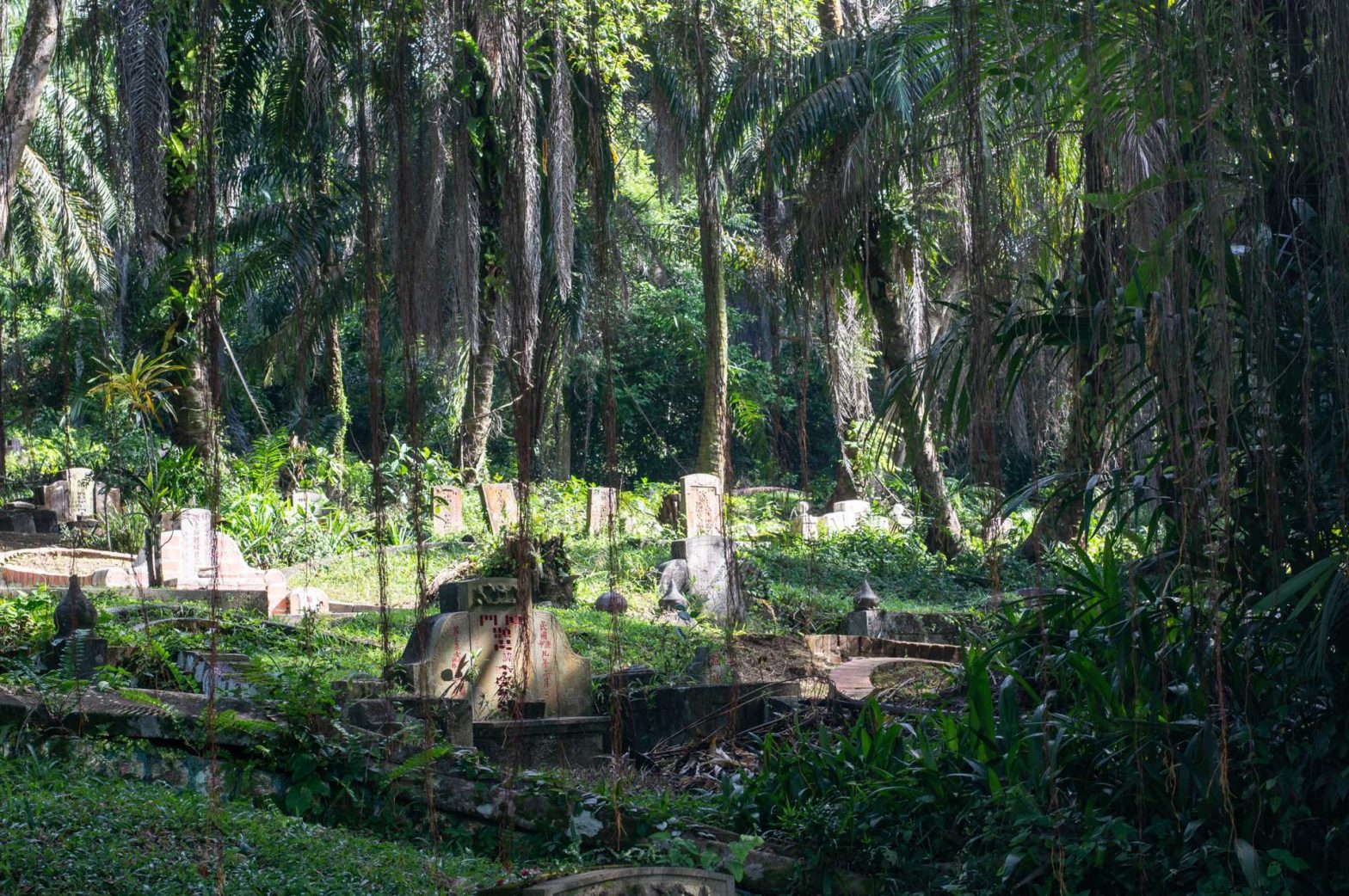By Vicky · Published Jan. 23rd, 2022 · Updated Nov. 28th, 2022
When you buy through links highlighted with an asterisk (*) on this site, we may earn a small affiliate commission at no cost to you.
On this hike see the famous black and white bungalows in Adam Park and the authentic Chinese Bukit Brown Cemetery on a jungle-covered hillside.
Adam Park and Bukit Brown Cemetery Hike Map
Get the route by downloading the .gpx or .kml file below. For navigation with Maps.me on your mobile phone, simply download the .kml file and open to add it to the Maps.me bookmarks.
Location
We started our hike from Botanic Gardens MRT. We walked to Adam Park and admired the gorgeous black and white bungalows before heading over to Bukit Brown Cemetery. After looking around the cemetery we walked to a nearby bus stop and caught a bus back to Tan Kah Kee MRT on the blue downtown line.
Tips for Adam Park and Bukit Brown Cemetry
- Real people live in the houses of Adam Park so keep the noise down and don’t be intrusive.
- In Bukit Brown Cemetery don’t walk over graves and be respectful.
- Take a sun hat, sunscreen and plenty of water along.
- Navigation offline maps app Maps.me works quite well but some of the trails marked are not an option in reality.
- Check out other hikes on our Singapore Hiking Page
From Botanic Gardens MRT we turned left along the road before crossing underneath a large highway. We then turned right, over the Rochor River, on a pavement beside the road. After 500 metres, just past a fuel station, a small road leads off to the left. We took this little road into the Adam Park neighbourhood.
Adam Park: Black and White Bungalows
Adam Park is a lovely neighbourhood with beautiful black and white bungalows set among luscious green jungle. Both roads we walked on within the neighbourhood are one-way, and since there are only a few houses it meant we didn’t see any cars. Grassy open spaces dotted with trees appear along the side of the roads.
History and Architecture of the Black and White Bungalows
Adam Park and the Black and White Bungalows found here were developed in 1925-1929. It was designed as housing for senior officers in the British administration who governed Singapore at the time. Later, in 1942, there was fierce fighting here against the Japanese before the British Army eventually retreated.
They are called Black and White Bungalows because of their colour scheme – black timber and whitewashed walls. All large houses in colonial Singapore were known as Bungalows, even though elsewhere a bungalow just means a house without stairs. These Bungalows all have steep, overhanging roofs designed to shed the heavy tropical rain efficiently.
A large part of the design is to keep the building cool – the steep roof draws in air, tiles line the ground floor rooms and large verandahs allow sitting outside in the dry while shading the house.
After walking up the first dead-end road until the lovely house at the end (my favourite), we retraced our footsteps and headed up the second dead-end road slightly further along. This road had even larger bungalows set in expansive grounds on either side. The road climbs a hill so you get some views over the surrounding area.
After retracing our steps once more, we arrived back at the main road. We turned left to cross the pedestrian bridge overhead and onto a park connector (part of the coast-to-coast). Continuing left along the pavement, we followed the park connector around the corner until it ended in the tiny Kheam Hock Park. Here we took the underpass left beneath the highway and into the greater Bukit Brown Cemetery area.
Bukit Brown Cemetery
The character of the surroundings changes immediately as you pass beneath the highway. Suddenly trees and jungle surround you and there are very few cars. You can already see graves by the side of the road, partially covered by the encroaching vegetation.
Jungle Adventure in the Cemetery
After 300 m we saw a minor road to the right. There are signs saying ‘closed cemetery, but the entire cemetery is actually officially ‘closed’. There’s also a sign warning about wild dogs that might chase you. We ventured down this road a little way.
It was a beautiful track and we saw more graves, some with incense curling up into the sky. After walking a short way along the track, we turned back towards the main entrance to the cemetery as it was getting a little creepy and we didn’t want to meet the wild dogs.
Small Path through the Jungle
After walking along the main road for a short distance there are signs pointing right to the main cemetery entrance along a newly surfaced road. When we reached a bend in this road, we saw a small path heading off to the right and took this. This beautiful dirt trail heads through the jungle, with plants and trees consuming the barely visible graves.
The small dirt trail lasts about 500 metres and bends back around to join the main paved track through the cemetery. We turned right to walk around this paved track. The jungle here has been cleared and you can see hundreds, if not thousands of graves around this route.
Chinese Grave Design
The graves in Bukit Brown Cemetery are all designed with Feng Shui (wind-water) principles in mind. The top of the hills is much better than the marshy grounds below. Many graves have small moats around their base and funnels above to collect the most water – which represents wealth.
Many graves have tomb guardians – often lions and occasionally statutes of Sikh Guards. Sikhs were traditionally employed as police and guards in the 19th and early 20th centuries because of their often strong build and perceived military prowess. You can see more examples of Sikh Guard statues from this cemetery at the Indian Heritage Centre, a stop on our Litte India Walking Trail.
Look out for the grave on the left of the path with statues of Sikh Guards on either side. A little while later there is a small, easy-to-miss path going up to the largest family grave plot in the cemetery. There are a couple of brown posts with distance markings which highlight the narrow trail through the graves.
The Ong Sam Leong Family Graves
A short distance up the trail is the complex of graves belonging to the Ong Same Leong Family. The plot takes up a large area and is situated at the highest point of Bukit Brown. Ong Sam Leong was a very wealthy Peranakan businessman, like many trading in rubber, timber and ‘coolies’, or workmen. The position and size of his family grave plot shows how rich he must have been.
After returning down the path, we continued around the main loop. There were more graves and some beautiful trees and soon we were almost back to where we had entered the cemetery. From here we took the pavement by the side of the highway to reach the nearby bus stop. We took a bus back to Tan Kah Kee MRT, and from there home.
History of Bukit Brown Cemetery
Bukit Brown (or Brown Hill) is named after George Brown, a British businessman who came to Singapore in the mid-19th century and built his home near what is now the cemetery. It opened in 1922 as a place of burial for all Chinese residents in Singapore.
In 1970 the cemetery was closed and nobody has been buried there since, though people still visit the graves. It’s often peaceful and fairly empty apart from around the Qing Ming Festival, or Tomb-Sweeping Day, when people come to pay respects to their ancestors and make ritual offerings.
In 2011-2013 the government built a large highway (Lornie Highway) through the cemetery, exhuming thousands of graves. Today large parts of the cemetery have fallen into disrepair and nature is reclaiming the area, probably to be reclaimed later by building works and apartment blocks.
If you want to delve further into the graves and history of Bukit Brown Cemetery, check out the free self-guided trail by the Singapore Heritage Society.
Want to see more Singapore Heritage? Check out our heritage trails of Little India or Kampong Glam. For other hiking ideas check out our Singapore Hiking page.
FAQs: Adam Park and Bukit Brown Cemetery
Adam Park is a neighbourhood and you can wander through any time, though it’s dark after the sunsets.
Ong Sam Leong has the largest family gravesite in Bukit Brown, covering a large section of hillside. There are many other Chinese Singaporeans buried here with roughly 100,000 graves in the cemetery.
There are bus stops on either side of the Lornie Highway (before Kheam Hock Road and after Kheam Hock Rock) near the entrance of Bukit Brown. It’s easy to take a bus from Tan Kah Kee MRT station on the blue downtown line to the cemetery.
The cemetery is open all the time, though it may be dark and slightly scary after the sun sets.





